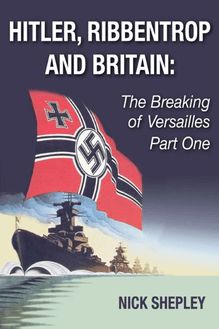Red Sun at War Part II , livre ebook
37
pages
English
Ebooks
2015
Vous pourrez modifier la taille du texte de cet ouvrage
Obtenez un accès à la bibliothèque pour le consulter en ligne En savoir plus
Découvre YouScribe en t'inscrivant gratuitement
Découvre YouScribe en t'inscrivant gratuitement
37
pages
English
Ebooks
2015
Vous pourrez modifier la taille du texte de cet ouvrage
Obtenez un accès à la bibliothèque pour le consulter en ligne En savoir plus
Publié par
Date de parution
07 décembre 2015
Nombre de lectures
0
EAN13
9781781663011
Langue
English
Poids de l'ouvrage
1 Mo
Publié par
Date de parution
07 décembre 2015
Nombre de lectures
0
EAN13
9781781663011
Langue
English
Poids de l'ouvrage
1 Mo
Title Page
RED SUN AT WAR PART TWO:
The Fall of Malaya and the Dutch East Indies
By
Nick Shepley
Publisher Information
Red Sun At War: Part Two published in 2012
by Andrews UK Limited
www.andrewsuk.com
This book is sold subject to the condition that it shall not, by way of trade or otherwise, be lent, resold, hired out or otherwise circulated without the publisher’s prior written consent in any form of binding or cover other than that in which it is published, and without a similar condition being imposed on the subsequent purchaser.
Copyright © Nick Shepley
The right of Nick Shepley to be identified as author of this book has been asserted in accordance with section 77 and 78 of the Copyrights Designs and Patents Act 1988.
Introduction
On January 2 nd 1942, weeks after the devastating blows against America and Britain in the Far East that were delivered with the attack on Pearl Harbour, the invasion of the Philippines, Hong Kong, Malaya and the sinking of the HMS Prince of Wales and the Repulse, the Sydney Morning Herald Newspaper in Australia summed up a mood of growing panic:
“It is not too late for the Australian Government to plan and prepare this people for a ‘scorched earth’ policy, guerrilla fighting, and all else that total war entails.
The tone was only to become more panicked in Australia in the coming weeks as further bad news mounted up. Not only had America’s naval presence in the Pacific been devastated by Japan, but soon the British would experience their own disaster.
When Singapore fell on February 15th 1942, leading to the capture of the entire Australian 8th Division (who had been shipped there expressly at Winston Churchill’s orders to defend the island) the Royal Naval presence in the Indian Ocean and the South Pacific was lost, leaving Australia feeling frighteningly isolated. The subsequent bombing of Darwin in Australia’s Northern Territory seemed to confirm to the Australians that an invasion was imminent.
This ebook, following on from Red Sun At War: Pearl Harbour and Japan’s Pacific Gamble, will examine how two Empires, the British and the Dutch, crumbled under Japan’s onslaught, and how their allies, Indian, Australian, American and Chinese tried in vain to fight Japan’s advance. This ebook will also examine how little of this was actually inevitable, and how much rested on miscalculations, blunders and imperial overstretch.
The Prince of Wales and the Repulse
If one warship represented Britain’s continued ability to fight on through the troubled year of 1941 it was the Prince of Wales. Launched in 1936 and perhaps the most iconic and powerful British ship of its time, it landed a critical blow on the German battleship Bismarck, during the Battle of the Denmark Strait. The eventual destruction of the Bismarck, whilst having little overall effect of the Battle for the Atlantic, at the very least showed Germany that Britain had not given up the fight and could still inflict humiliating losses on her.
The second high profile mission of the Prince of Wales in 1941 was the ferrying of Winston Churchill to the Newfoundland Conference, where among other things, the principals of the Atlantic Charter, the vision for the post war world were agreed.
It seemed inconceivable to Churchill, or to his cabinet, that the battleship could be lost at all, based on the lessons learned in the Atlantic. When facing German naval power, which was often treated by Hitler as something of an afterthought (for more on this see my ebook Hitler, Ribbentrop and Britain), the Royal Navy could afford to think in more conventional terms, Germany had put no investment into building aircraft carriers. However, when in came to facing Japan, the British would have to learn the same painful lessons in the necessity of naval air power they had taught the Italians at Taranto in 1940.
“I turned in the water to face her, it was an unbelievable sight. The bow rose in the air to a tremendous height and with her propellers still turning; slowly began to go under. The saddest thing was that within minutes the sea was calm once again; no sign of her or the epic battle she put up before succumbing to the overwhelming odds that finally destroyed her”.
The sailor who wrote the passage above, in the official reports of the loss to two of the Royal Navy’s flagships, described one of the most shattering blows the navy faced throughout the war. The British public, perhaps cheered by the prospect of America joining the war following Pearl Harbour were stunned by the loss of the Prince of Wales and the Repulse days later. Ironically it was the British failure to give either of the ships air cover that decided their fate, and also indicated that there were still plenty of men in the Admiralty who had no understanding of the new rules of warfare.
The order to send the Repulse into battle against Japan had come on December 6th, just hours before the attack on Pearl Harbour commenced. Admiral Sir Thomas Phillips the Commander of the Royal Navy, Far East, was being briefed by US Admiral Thomas C. Hart, the commanding officer of the US Asiatic Fleet. The two men were discussing the best way to coordinate US and British naval forces in the Far East so that all strategic objectives of both powers could be met. It was abundantly clear to both men that war with Japan was most likely days or weeks away. Neither was aware that it was only a matter of hours.
The meeting was interrupted by one of Hart’s subordinates, who had an urgent report from the Admiralty for Phillips. An Australian spotter plane had seen Japanese troop transports sailing from Japanese conquered French Indochina southward. The route they were taking was possibly for Thailand, but more likely British Malaya. The first sighting was of only three warships, but moments later a long column of vessels, twenty five in total, was spotted. Their escorts were a further 13 warships, it was unmistakably and invasion fleet.
Hart mobilised what ships he had. Four destroyers, anchored in Balikpapan on the Eastern coast of Borneo were sent to intercept the fleet and the battle cruiser Repulse, en route to Darwin, was ordered to return to Singapore as quickly as possible. Both the Repulse and the Prince of Wales had been ordered to Singapore days beforehand, they were meant to act as a deterrent to Japan who had a force that the Admiralty assumed was approximately nine battleships strong. Churchill was more focused on the improving situation in the Atlantic and the Mediterranean and was less concerned about the claims by First Sea Lord Sir Dudley Pound, that the force sent to protect Singapore would be hopelessly outgunned.
The British were facing a crisis that their enemies in Germany, Italy and even Russia had long anticipated, that of imperial overstretch. Having to defend a global empire and also defend the British Isles, at the same time that new, leaner and more innovative naval powers were flexing their muscles, was an extremely tall order, even for Britain.
One of the mysteries that lie at the heart of Japan’s initial wartime successes, is the rather last minute and rushed nature of the preparations. As we have seen, a decision to attack Pearl Harbour and then the Dutch East Indies was undertaken only late in 1941, when it became clear that negotiations with America over China had broken down, resulting in an oil embargo. The Japanese had a number of objectives in Malaya, perhaps the foremost of these was its vast resources of rubber and tin. If it seized these, it could control much of the world’s rubber production, a commodity that America was highly dependent on. Singapore was an equally vital objective, as the Japanese knew that much British power in the far east was dependent on their island base, when Singapore fell, General Tomoyuki Yamashita the ‘Tiger of Malaya’ described it as the screw at the centre of a fan, without it, the rest of British power in Asia would collapse.
Much was made by the Japanese in the prelude to the attack about their laudable and emancipatory goals in the Far East. Prime Minister Tojo pledged that once European settlers had been forcibly evicted, Burma and the Philippines would be given independence and that as long as other regional powers, including Australia, towed the line, there would be little need for violence. Yamashita and his officers are often cited as having professed a desire to see the back of Europeans, and Malays, Burmese, Indians and Indonesians certainly viewed the Japanese if not exactly as liberators, then certainly presenting an excellent opportunity to free themselves from European control. The scale of violence and hunger that Japan was to bring to her new empire in the three short years she possessed it, however, would very quickly push most of the newly ‘liberated’ colonies back into the arms of their former European masters.
Even Malaya featured highly in the war plans of the Japanese high command, Yamashita was given just one month to prepare an invasion, and it makes his victories all the more remarkable. Had the British known the short term and ad hoc nature of the preparations, they would perhaps have been less likely to capitulate as quickly as they did. Yamashita was far from a favourite of Tojo’s, having been associated with a coup against the government in 1937. Yamashita had been loosely affiliated with the Koda-Ha group or ‘Imperial Way’ a far more aggressive, imperialistic and war like cabal in the Japanese military, and Koda-Ha is worth investigating here, because it give us insights into the barbarity that was unleashed in 1942.
Throughout the 1920s and 1930s the gradual encroachment of modernity into the only very recently post feudal Japan alarmed many traditionalists and those who viewed their Samurai a











